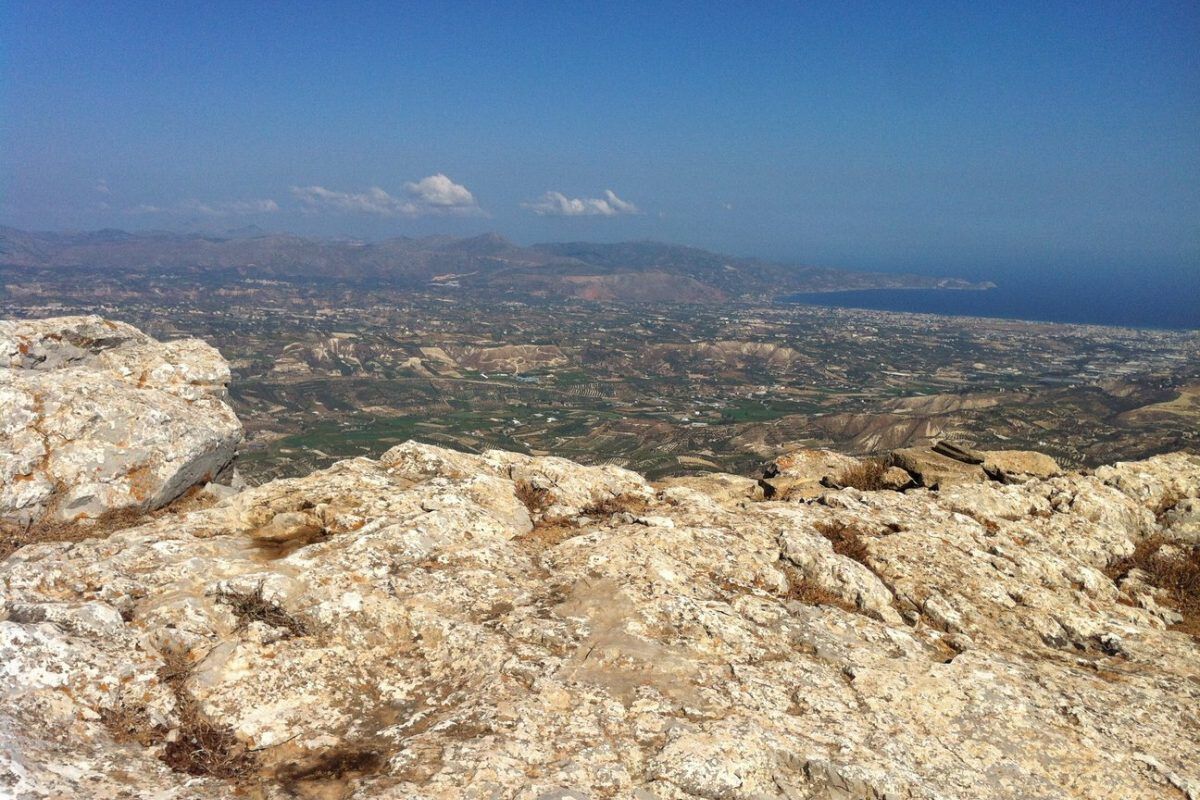Juktas Peak Sanctuary: An Ancient Minoan Site
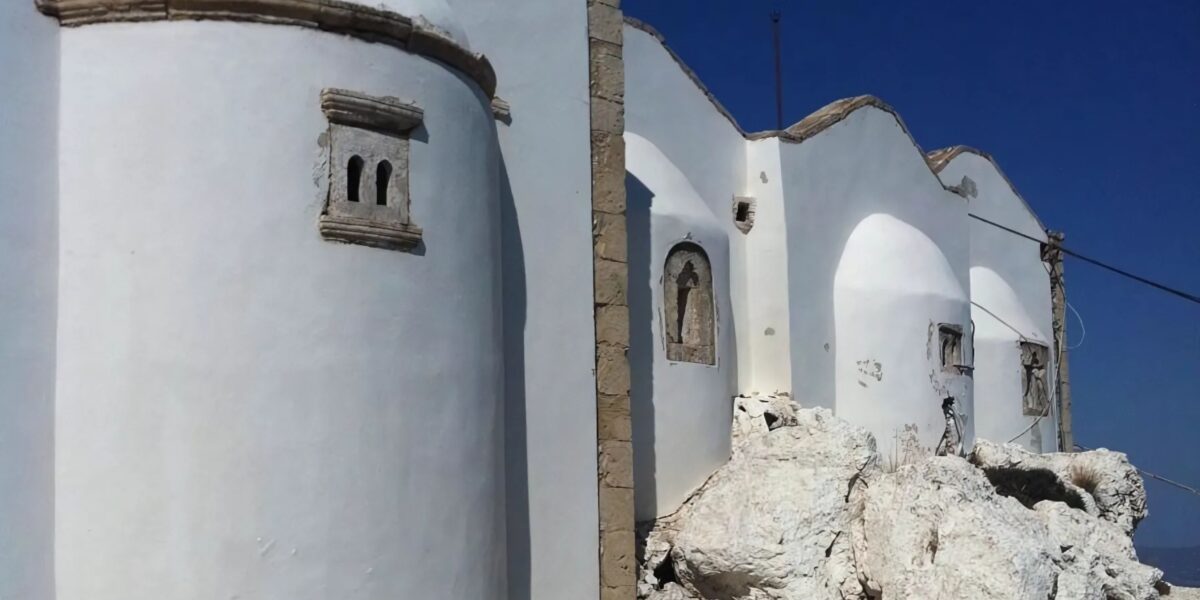
In the center of Minoan Crete, Juktas Peak Sanctuary stands tall above the land.
This place is more than just a mountain. It was very important for the Minoans’ religion. The site gives us insight into their beliefs and rituals. It also shows how nature and spirituality were connected during the Bronze Age in Crete.
The Location of Juktas Peak Sanctuary
The Juktas Peak Sanctuary, also known as Psili Korfi, is located 13 kilometres south-west of Knossos, from where the mountain peak can be seen. To the east of the sanctuary lies the village of Archanes, which was the site of a major Minoan settlement, possibly including a palace. Unfortunately, the modern village was built on top of the Minoan site so a complete excavation has proved impossible. When Arthur Evans excavated the Juktas site he uncovered what he considered to be a priest’s house of the early Aegeo-Cretan “but and ben” type.
The Significance of the Location of Juktas Peak Sanctuary
Many cultures see mountains as important in their spiritual beliefs. The Minoan civilization is a prime example. They built peak sanctuaries on mountain tops. These high locations were seen as closer to the heavens and their deities. Juktas is one of the most important peaks in central Crete and became a key site for this belief.
The Juktas Peak Sanctuary was not just high; it was also easy to see from far away. When standing on the peak, you can look out over a large area of land and sea. This strong view would make the mountain seem like a powerful symbol, representing both earthly and divine authority.
Excavations of Juktas Peak Sanctuary
The first digging at Juktas Peak Sanctuary started in 1909. The well-known archaeologist Arthur Evans led this effort. He discovered some mysteries of this ancient place, giving us exciting hints about its Minoan past. However, it was not until 1974 that we started to understand the site better. Alexandra Karetsou led this new round of excavations. Karetsou found important features like stepped terraces, an altar, and several rooms. These discoveries showed that people used the site for rituals. They helped to confirm how important this sanctuary was to Minoan religion.
Deep Dive in the 1974 Excavations
Excavations at the site were re-commenced in 1974 and conducted by Alexandra Karetsou, whose article in “Sanctuaries-Cults in the Aegean Bronze Age” provides the basis for this account. It very soon emerged that what Evans had called a priest’s house had, in fact, been the main part of the open air sanctuary which consists of two stepped terraces, oriented north-south. These are reached from the ramp which Evans identified, lying directly to the south.
Terraces and Fissures at a Minoan Peak Sanctuary
On the west side of the terraces there is an altar of which the preserved remains measure 4.7 metres long and 50 centimetres high. The altar was built on the edge of one of a number of fissures on the top of the mountain. This particular fissure has been excavated to a depth of ten metres (but not to the bottom) and produced a large number of interesting finds.
To the east of Terrace II, a series of fives rooms was found, running south to north. These rooms were probably not central to the worship that was conducted at the shrine. The northern part of the site remains to be fully excavated. Unfortunately the national telephone company built a radar station within the Peak Sanctuary site in 1952, probably destroying the Minoan remains in this area. A possible third terrace exists to the east of the series of rooms, and this, too, awaits investigation.
The terraces were built either at the end of the Old Palace period or at the beginning of the New Palace period. The majority of sherds in terrace I come from MM I-II. The existence of MM IA sherds in the deepest fissures of the rocks all over the peak suggest a sanctuary of the prepalatial period or the existence of other, early religious practices on this site.
The excavator of the site concluded that the peak sanctuary was the public open-air sactuary of the Knossos area in the Old Palace period. In MM III however, when the new palaces were built, the connection with the Palace of Knossos becomes clearer because the architectural remains are monumental when compared with other peak sanctuaries that have been excavated. Also, the quality of the finds has a palatial character.
New Excavations Reveal Monumental Terraces and a Cyclopean Wall
The sanctuary is enclosed by a wall of genuine cyclopean construction. The wall is 735 metres long and over three metres wide. It is about 3.5 metres high. One strange fact about the wall is that on the south and east sides, the wall is very close to the Minoan sanctuary, but its north side, where the entrance is to be found, is 410 metres away from the sanctuary. This raises the question of whether the wall is in fact the temenos wall of the sanctuary or not. Various dates have been proposed for the building of the wall from MM IA to LM III, but the only evidence to come to light so far has been an offering table dating to the MM III/LM I periods which had been built into the wall.
What makes Juktas Peak Sanctuary Unique in Minoan Archaeology?
Juktas Peak Sanctuary is unique among Minoan peak sanctuaries for a few key reasons. First, digs by Arthur Evans show that it was used for a long time. This means religious practices continued here from the Middle Minoan period, making it one of the oldest Minoan peak sanctuaries. Second, its grand buildings, especially when compared to other peak sanctuaries, suggest a close link to the palace at Knossos. This connection shows that Juktas had an important role in the larger social and political scene of Minoan Crete. Finally, the large number and high quality of the artifacts found here indicate that Juktas Peak Sanctuary was special. These items often seem tied to the palace, which hints that it might have served as a royal sanctuary.
Are there any Particular Artifacts or Findings that Stand Out at Juktas Peak?
The Juktas Peak Sanctuary has given us many important artifacts. These items help us understand Minoan religious practices. Notably, there are many pottery pieces and complete jars from the Middle Minoan III period. These finds show there was a lot of ritual activity during that time. We have also found inscriptions written in the mysterious Linear A script at this sanctuary. We still cannot decode this language, but these writings likely give hints about the deities worshipped, the rituals done, and the people who visited this sacred site. All these artifacts create a clear picture of a lively religious center. It was a place where Minoans gathered to honor their gods and feel connected to the divine. These pieces from the past help us get a glimpse of the rituals and beliefs that once took place on this sacred mountain.
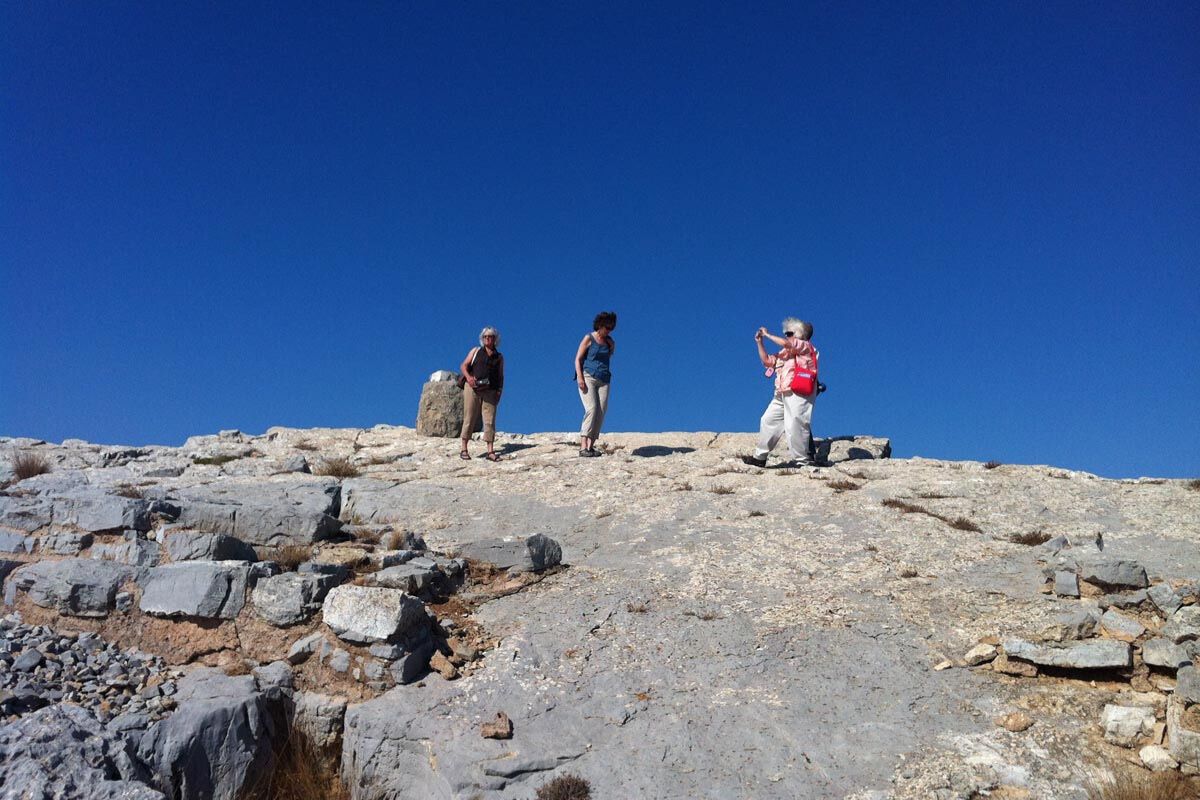
Secrets of Juktas Peak Sanctuary
Mount Juktas stands tall and has a deep history that people find fascinating and mysterious. It is not just an important archaeological site; its stories are also part of local legends and folklore. Many believe that Zeus rests here, and others talk about the mountain’s wild herbs that supposedly have healing powers. Juktas sparks imagination and connects the past with today. This unique mountain attracts numerous visitors from all around the world.
Wild Herbs with Healing Properties
The Final Resting Place of Zeus
Mount Juktas is special in Greek mythology. People often link it to Zeus, the king of the gods. According to legend, ancient people buried Zeus on this sacred mountain. From one angle, the mountain looks like a man with a beard lying down, which adds to this belief. Old writers talked about sacred caves in the mountain. They thought these caves were Zeus’s tomb. There are four caves, each reflecting the main directions, which makes them even more mysterious. Even though archaeologists have found no proof that ancient people buried Zeus at Juktas, the legend lives on. It is an important part of the mountain’s story. These examples demonstrate the strength of mythology and show how these ancient ideas connect to the land of Greece.
Worshipping Saints
The spiritual meaning of Mount Juktas goes beyond the fall of the Minoan civilization. When Christianity rose, the mountain became a worship site for Greek Orthodox believers. This change shows how sacred places can adapt with the changing beliefs of people. A symbol of this lasting respect is a small, white Greek Orthodox chapel located on the slopes of the mountain. Every year, people from nearby towns and villages walk up the paths to the chapel, bringing flowers and candles. They come to honor the saints and ask for their help and blessings. The yearly journey to the chapel shows the strong link between faith, community, and the landscape. It emphasizes how Mount Juktas remains a place for expressing belief, keeping traditions alive, and joining the past with the present.
Ritual Sacrifices at Anemospilia
On the slopes of Juktas is Anemospilia. This site gives a chilling look into the darker aspects of Minoan religion. Excavations in 1979 revealed a small shrine from the Middle Minoan period. What shocked the archaeological community was the discovery of four human skeletons. Their positioning, along with other artifacts found at Anemospilia, suggests that it may have been a site for ritual sacrifice. This could have included human sacrifice. Such discoveries challenged the idea of Minoans as simply peaceful, nature-loving people. They showed a more complex side to their religious practices. Debates still go on about what happened at Anemospilia. This site stands as a strong reminder that even in seemingly perfect societies, the lines between life and death, and between faith and violence, could sometimes blur in the quest for religious devotion.
A View That Captures the Spirit of Icarus
Standing on Mount Juktas, looking at the wide view, you can feel excitement and freedom. The sight is amazing. You see the deep blue Aegean Sea, the rolling hills full of olive trees, and the distant mountains often covered with clouds. It’s easy to understand why the Minoans thought this place was special, somewhere where heaven and earth meet. Maybe it was here, at this spot high above the ground, where the story of Icarus began. You can almost see young Icarus, with his wings made of feathers and wax, flying high. He felt so free. For a short, wonderful moment, he touched the sun, and reached heights that showed the dreams of people everywhere.
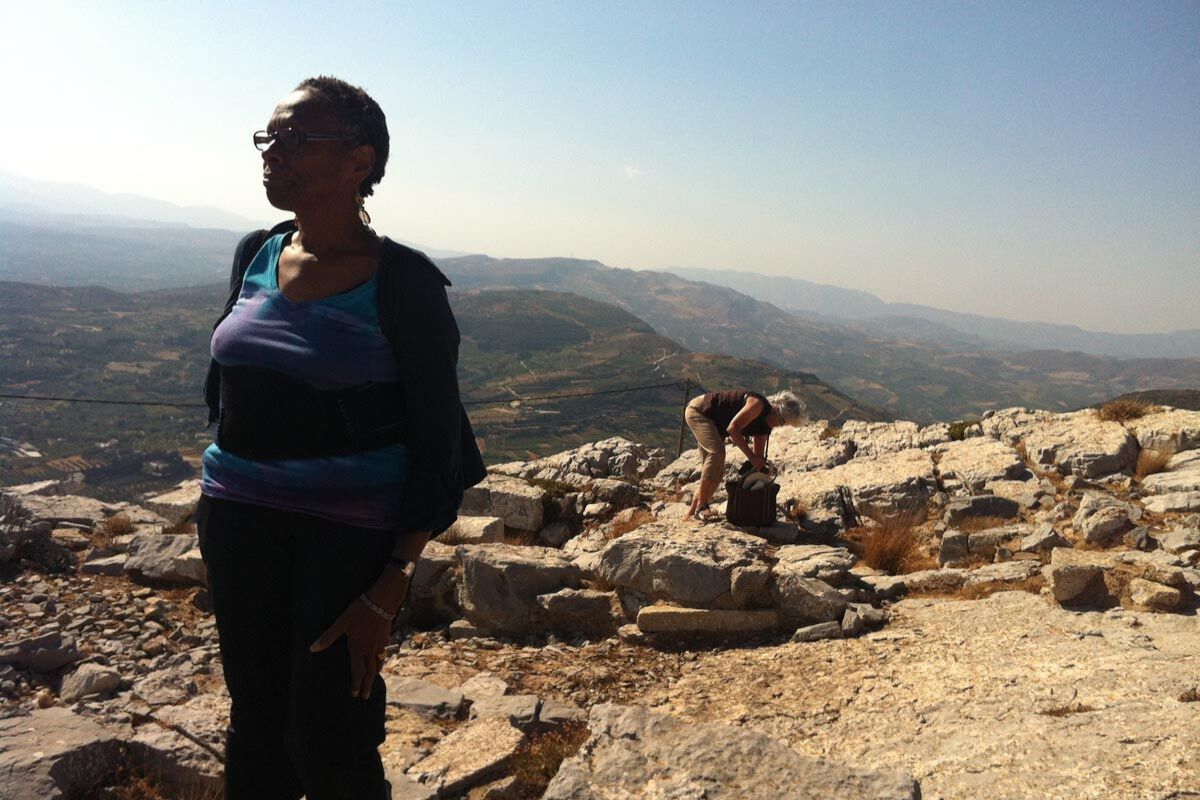
The Spiritual and Cultural Heart of Minoan Civilization
Juktas Peak Sanctuary offers a stunning view and a strong feeling of spirituality. It lets us see into the beliefs of the Minoans. The place shows how important mountains were to them as sacred spots. The signs of rituals and ceremonies on Juktas reveal a society closely tied to nature. They did not treat mountains, caves, and natural elements as mere scenery; instead, they integrated them as key parts of their religious practices.
Rituals and Ceremonies
We don’t have a written record of the exact beliefs and practices at Juktas Peak Sanctuary. However, the archaeological signs show there were many rituals and ceremonies. For instance, the altar suggests that animal sacrifices took place, possibly along with gifts of food, drink, and valuable items. The finding of pottery pieces, many with unique designs, shows that feasts and drinks were probably important parts of the rituals. These gatherings may have allowed the community to unite, strengthen their ties, and ask the gods for help and good fortune. Also, the terraces and rooms indicate that Juktas was not just for occasional rituals. It was a real religious sanctuary where priests and worshippers probably stayed for long times. They took care of the sacred space and kept up religious practices.
The Mountain Goddess Worshipping
Scholars do not know which gods or goddesses people worshipped at the peak sanctuaries. Evans and Nilsson, among others, have discussed the Mountain Mother and her young male god or companion, identified as Velchanos or Hyakinthos. Researchers propose that the site may link to the new-born child Dias or Zeus. Originally he may have been the spirit of the wealth of the earth, although mythology was to assign to him a different role under the Ancient Greeks.
Platon believed that the peak sanctuary was a royal sanctuary because of the quantity of previous material found there. He believed that the Archanes buildings shared a connection with the sanctuary in some way. There was even a road joining the two. Platon believed that the building excavated by A. Karetsou on Iuktas corresponded to the tripartite shrines represented on vases. The rooms in front of the terrace would correspond to the front rooms of these tripartite shrines.
Peter Warren has emphasised the long period during which the shrine was in use, arguing that this points to the continuity of the Minoan religion. He also pointed out that the presence of the the fissure next to the altar links the peak sanctury cult to the cave sanctuary cult as integral parts of Minoan religion.
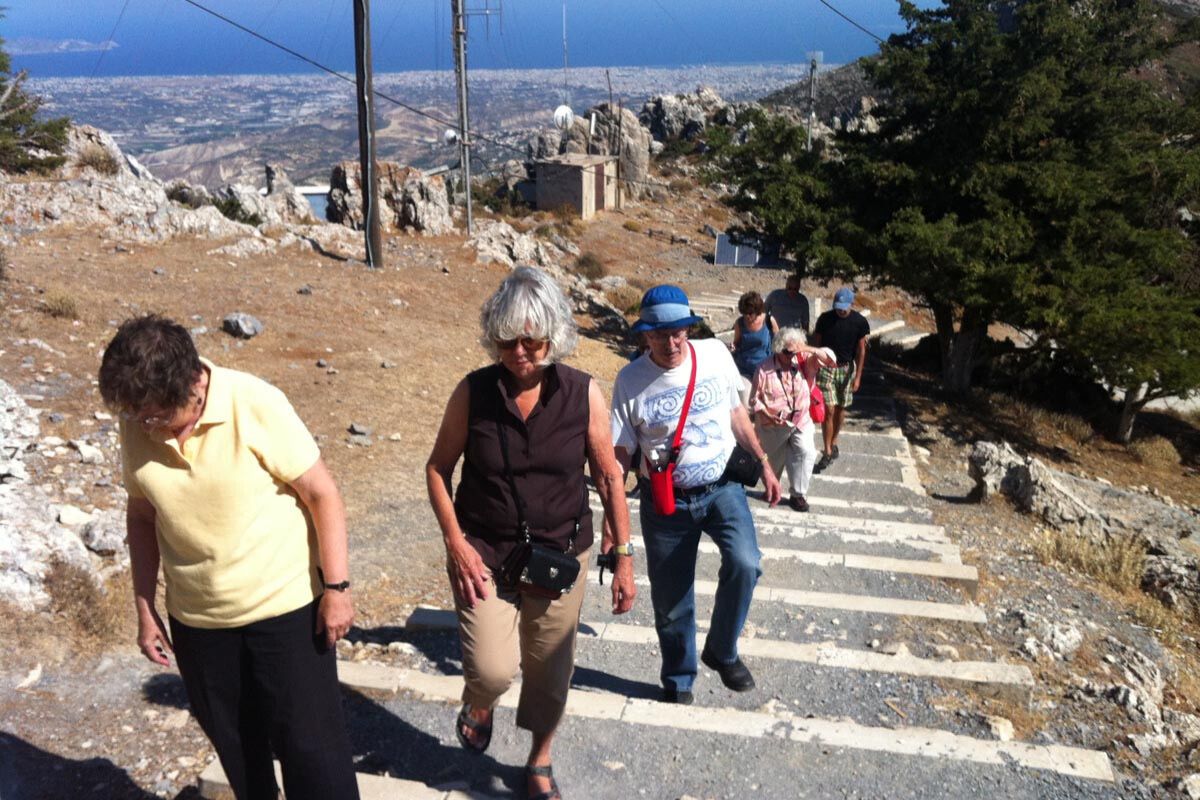
Can Visitors Explore Juktas Peak Sanctuary Today, and What Should they Expect?
Yes, Juktas Peak Sanctuary welcomes visitors who want to feel the magic of this old site. It is near Heraklion, and you can get there by hiking a beautiful but tough trail. This trail goes through sweet-smelling pine trees and rocks. You will also see the stunning views of the Cretan landscape.
If you are interested in visiting this sacred hill, click on our experience “Artistic and Spiritual Crete” for more information.
When you reach the top, you will enjoy amazing views all around. Archaeologists have dug out parts of the sanctuary, which you can now explore. Even though only some of the site is open, you can see the terraces, the altar, and a strange crack in the rock. These sights can spark your imagination about the rituals and beliefs that took place on this sacred mountain.
Juktas Peak Sanctuary shows the great Minoan civilization. It gives us a look at their beliefs and ways of life. The site has unique items like healing herbs and signs of rituals. These items help us understand their old traditions better. Zeus and ancient rituals connect Mount Juktas, making it special for anyone interested in history. Visiting this sacred sanctuary offers a fun trip back in time. You can feel what Minoan culture was like. Plan your visit now and start exploring this amazing archaeological site.

